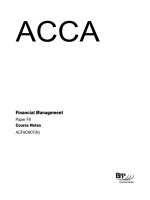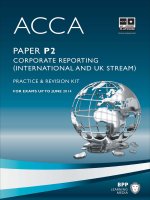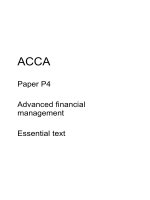ACCA recording financail transactions FA1 syllabus
Bạn đang xem bản rút gọn của tài liệu. Xem và tải ngay bản đầy đủ của tài liệu tại đây (204.16 KB, 12 trang )
Recording Financial
Transactions
(FA1)
Syllabus and study guide
September 2019 to August 2020
© ACCA 2019-2020 All rights reserved.
1
SUMMARY OF CONTENT
INTRODUCTION
1. Intellectual levels
2. Learning hours and educational recognition
3. Guide to ACCA examination structure
4. Guide to ACCA examination assessment
RECORDING FINANCIAL TRANSACTIONS
SYLLABUS
5. Qualification Structure
6. Relational diagram linking Recording
Financial Transactions with other exams
7. Overall aim of the syllabus
8. Rationale
9. Main capabilities
10. Approach to examining the syllabus
11. The syllabus
RECORDING FINANCIAL TRANSACTIONS STUDY
GUIDE
12. Detailed study guide
13. Summary of changes to Recording Financial
Transactions
2
© ACCA 2019-2020 All rights reserved.
1. INTELLECTUAL LEVELS
ACCA qualifications are designed to progressively
broaden and deepen the knowledge and skills
demonstrated by the student at a range of levels
through each qualification.
Throughout, the study guides assess both
knowledge and skills. Therefore a clear distinction is
drawn, within each subject area, between assessing
knowledge and skills and in assessing their
application within an accounting or business
context. The assessment of knowledge is denoted by
a superscriptK and the assessment of skills is
denoted by the superscriptS.
2. LEARNING HOURS AND EDUCATIONAL
RECOGNITION
As a member of the International Federation of
Accountants, ACCA seeks to enhance the education
recognition of its qualification on both national and
international education frameworks, and with
educational authorities and partners globally. In
doing so, ACCA aims to ensure that its qualifications
are recognized and valued by governments,
regulatory authorities and employers across all
sectors. To this end, ACCA qualifications are
currently recognized on the education frameworks in
several countries. Please refer to your national
education framework regulator for further
information about recognition.
For specified financial accounting, audit and tax
examinations, except where indicated otherwise,
ACCA will publish examinable documents once a
year to indicate exactly what regulations and
legislation could potentially be assessed within
identified examination sessions.
For this examination regulation issued or legislation
passed on or before 31st August annually, will be
assessed from September 1st of the following year to
August 31st of the year after. Please refer to the
examinable documents for the exam (where
relevant) for further information.
Regulation issued or legislation passed in
accordance with the above dates may be
examinable even if the effective date is in the future.
The term issued or passed relates to when
regulation or legislation has been formally approved.
The term effective relates to when regulation or
legislation must be applied to entity transactions
and business practices.
The study guide offers more detailed guidance on
the depth and level at which the examinable
documents will be examined. The study guide
should therefore be read in conjunction with the
examinable documents list.
3. GUIDE TO ACCA EXAMINATION
STRUCTURE AND DELIVERY MODE
The structure of examinations varies.
The Foundations examinations contain 100%
compulsory questions to encourage candidates to
study across the breadth of each syllabus.
All Foundations examinations are assessed by twohour computer based examinations.
The pass mark for all FIA examinations is 50%.
4. GUIDE TO ACCA EXAMINATION
ASSESSMENT
ACCA reserves the right to examine anything
contained within any study guide within any
examination session. This includes knowledge,
techniques, principles, theories, and concepts as
specified.
© ACCA 2019-2020 All rights reserved.
3
5. QUALIFICATION STRUCTURE
The qualification structure requires candidates who wish to be awarded the ACCA Diploma in Financial and
Management Accounting (RQF Level 2) to pass both the FA1 and MA1 examinations and successfully complete
the Foundations in Professionalism module.
6. RELATIONAL DIAGRAM LINKING RECORDING FINANCIAL TRANSACTIONS WITH OTHER EXAMS
The FIA suite of qualifications is designed so that a student can progress through three discrete levels; RQF Level
2, 3, and 4. However, entry is possible at any point. Students are recommended to enter Foundations in
Accountancy at the level which is most appropriate to their needs and abilities and to take examinations in order,
but this is not a requirement.
4
© ACCA 2019-2020 All rights reserved.
7. OVERALL AIM OF THE SYLLABUS
To develop knowledge and understanding of the
main types of business transactions and
documentation and how these are recorded in an
accounting system up to the trial balance stage.
8. RATIONALE
The syllabus for FA1, Recording Financial
Transactions, introduces the candidate to the
fundamentals of preparing and recording financial
documentation from originating documents and
processing ledger transactions up to the trial
balance stage. It also covers relevant banking
procedures associated with bookkeeping,
maintaining and reconciling cash and petty cash
records and preparing the journal and relevant
control accounts and identifying and correcting
errors.
© ACCA 2019-2020 All rights reserved.
5
9. MAIN CAPABILITIES
On successful completion of this exam, candidates should be able to explain and understand the following:
6
A
Types of business transactions and documentation
B
Duality of transactions and the double entry system
C
Banking system and transactions
D
Payroll
E
Ledger accounts
F
Cash and bank
G
Sales and credit transactions
H
Purchases and credit transactions
I
Reconciliation
J
Preparing the trial balance
© ACCA 2019-2020 All rights reserved.
10. APPROACH TO EXAMINING THE
SYLLABUS
The syllabus is assessed by a two hour computerbased examination. Questions will assess all parts of
the syllabus and will include both computational
and non-computational elements. The examination
will consist of 50 two mark questions.
11. DETAILED SYLLABUS
A
Types of business transactions and
documentation
1.
Types of business transaction
2.
Types of business documentation
3.
Process of recording business transactions
within the accounting system
G
Sales and credit transactions
1.
Recording sales
2.
Customer account balances and control
accounts
H
Purchases and credit transactions
1.
Recording purchases
2.
Supplier balances and reconciliations
I
Reconciliation
1. Purpose of control accounts and reconciliation
2. Reconcile the cashbook
B
Duality of transactions and the double entry
system
1.
Books of prime entry
2.
Double entry system
3.
The journal
4.
Elements of financial statements
C
Banking system and transactions
1.
The banking process
2.
Documentation
D
Payroll
1.
Processing payroll transactions into the
accounting system
E
Ledger accounts
1.
Prepare ledger accounts
F
Cash and bank
1.
Maintaining a cashbook
2.
Maintaining a petty cashbook
3. Reconcile the receivables control account
4. Reconcile the payables control account
J
Preparing the trial balance
1. Prepare the trial balance
2. Correcting errors
© ACCA 2019-2020 All rights reserved.
7
12. DETAILED STUDY GUIDE
A
1.
a)
TYPES OF BUSINESS TRANSACTION AND
DOCUMENTATION
3.
Process of recording business transactions
within the accounting system
a)
Identify the characteristics of accounting data
and the sources of accounting data records,
showing understanding of how the accounting
data and records meet the business’
requirements. [K]
b)
Understand how users locate, display and
check accounting data records to meet user
requirements and understand how data entry
errors are dealt with. [K]
c)
Outline the tools and techniques used to
process accounting transactions and period-end
routines and consider how errors are identified
and dealt with. [K]
d)
Consider the risks to data security, data
protection procedures and the storage of
data.[K]
Types of business transaction
Understand a range of business transactions
including:[K]
i) Sales
ii) Purchases
iii) Receipts
iv) Payments
v) Petty cash
vi) Payroll
b) Understand the various types of discount
including, where applicable, the effect that
trade discounts have on sales tax.[K]
c) Describe the processing and security procedures
relating to the use of:[K]
i) Cash
ii) Cheques
iii) Credit and debit cards
iv) Debit cards for receipts and payments and
electronic payment methods
2.
Types of business documentation
a)
Outline the purpose and content of a range of
business documents to include but not limited
to: [K]
i) Invoice
ii) Credit note
iii) Remittance advice
b)
c)
d)
8
e)
Understand the principles of coding in entering
accounting transactions including: [K]
i) Describing the need for a coding system for
financial transactions within a double entry
bookkeeping system
ii) Describe the use of a coding system within
a filing system
f)
Code sales invoices, supplier invoices and
credit notes ready for entry into the books of
prime entry.[S]
g)
Prepare the financial documents to be sent to
credit customers including: [S]
i) Sales invoices
ii) Credit notes
iii) Statements of account
Describe the accounting documents and
management reports produced by
computerised accounting systems and
understand the link between the accounting
system and other systems in the business. [K]
B
DUALITY OF TRANSACTIONS AND THE
DOUBLE ENTRY SYSTEM
Prepare remittance advices to accompany
payments to suppliers. [S]
1.
Books of prime entry
a)
Outline the purpose and content of the books
of prime entry including their format.[K]
b)
Explain how transactions are entered in the
books of prime entry.[K]
Prepare a petty cash voucher including the
sales tax element of an expense when
presented with an inclusive amount. [S]
© ACCA 2019-2020 All rights reserved.
c)
Outline how the books of prime entry integrate
with the double entry bookkeeping system [K]
d)
Enter transactions including the sales tax effect
where applicable into the books of prime
entry.[S]
Outline the processing and security procedures
relating to the use of cash, cheques, credit
cards and debit cards for receipts and
payments and electronic payment methods.[K]
d)
2.
Documentation
2.
Double entry system
a)
Explain why it is important for an organisation
to have a formal document retention policy. [K]
a)
Define the accounting equation. [K]
b)
Identify the different categories of documents
that may be stored as part of a document
retention policy.[K]
D
PAYROLL
1.
Process payroll transactions within the
accounting system
b)
Understand and apply the accounting
equation.[K]
c)
Understand how the accounting equation
relates to the double entry bookkeeping
system.[K]
d)
Process financial transactions from the books
of prime entry into the double entry
bookkeeping system.[S]
3.
The journal
a)
Understand the use of the journal including the
reasons for, content and format of the
journal.[K]
b)
Prepare journal entities directly from
transactions, books of prime entry as
applicable or to correct errors.[S]
a)
Prepare and enter the journal entries in the
general ledger to process payroll transactions
including:
i) Calculation of gross wages for employees
paid by the hour, paid by output and
salaried workers
ii) Accounting for payroll costs and deductions
iii) The employers’ responsibilities for taxes,
state benefit contributions and other
deductions [S]
b)
Identify the different payment methods in a
payroll system, e.g. cash, cheques,
automated payment. [K]
c)
Explain why authorisation of payroll
transactions and security of payroll
information is important in an
organisation.[K]
4.
Elements of the financial statements
a)
Define and distinguish between the elements of
the financial statements.[K]
b)
Identify the content of a statement of financial
position and statement of profit or loss and
other comprehensive income.[K]
E
LEDGER ACCOUNTS
C
BANK SYSTEM AND TRANSACTIONS
1.
Prepare ledger accounts
1.
The banking process
a)
Enter transactions from the books of prime
entry into the ledgers.[S]
a)
Explain the differences between the services
offered by banks and banking institutions.[K]
b)
Record journal entries in the ledger accounts. [S]
c)
Balance and close off ledger accounts.[S]
b)
Describe how the banking clearing system
works.[K]
c)
Identify and compare different forms of
payment.[K]
© ACCA 2019-2020 All rights reserved.
9
F
CASH AND BANK
1.
Maintaining a cash book
a)
Record transactions within the cashbook,
including any sales tax effect where applicable.
d)
Prepare the receivables control account or
receivables ledgers by accounting for:[S]
i) Sales
ii) Sales returns
iii) Payments from customers including
checking the accuracy and validity of
receipts against relevant supporting
information
iv) Discounts
v) Irrecoverable debt and allowances for
irrecoverable debts including any effect of
sales tax where applicable
[S]
b)
Prepare the total, balance and cross cast cash
book columns.[S]
c)
Identify and deal with discrepancies.[S]
2.
Maintaining a petty cash book
H
PURCHASES AND CREDIT TRANSACTIONS
a)
Enter and analyse petty cash transactions in
the petty cash book including any sales tax
effect where applicable.[S]
1.
Recording purchases
b)
Balance off the petty cash book using imprest
and non imprest systems. [S]
c)
Reconcile the petty cash book with cash in
hand.[S]
d)
Prepare and account for petty cash
reimbursement.[S]
G
SALES AND CREDIT TRANSACTIONS
1.
Recording Sales
a)
b)
Enter supplier invoices and credit notes into the
appropriate book of prime entry.[S]
2.
Supplier balances and reconciliations
a)
a)
Record sales transactions taking into account:
i) Various types of discount
ii) Sales tax
iii) The impact on the sales tax ledger account
where applicable.[S]
b)
Prepare the financial documents to be sent to
credit customers.[S]
2.
Customer account balances and control
accounts
a)
10
Produce statements of account to be sent to
credit customers.[S]
c)
Explain the need to deal with discrepancies
quickly and professionally.[K]
© ACCA 2019-2020 All rights reserved.
Prepare the payables control account or
payables ledgers by accounting for: [S]
i) Purchases
ii) Purchase returns
iii) Payments to suppliers including checking
the accuracy and validity of the payment
against relevant supporting information
iv) Discounts
I
RECONCILIATION
1.
Purpose of control accounts and reconciliation
a)
Describe the purpose of control accounts as a
checking devise to aid management and help
identify bookkeeping errors. [K]
b)
Explain why it is important to reconcile control
accounts regularly and deal with discrepancies
quickly and professionally.[K]
Understand the purpose of an aged receivable
analysis. [K]
b)
Record purchase transactions taking into
account:
i) Various types of discount
ii) Sales tax
iii) The impact on the sales tax ledger account
where applicable [S]
2.
Reconcile the cash book
a)
Reconcile a bank statement with the cash
book. [S]
3.
Reconcile the receivables control account
a)
Reconcile the balance on the receivables
control account with the list of balances.[S]
4.
Reconcile the payables control account
a)
Reconcile the balance on the payables control
account with the list of balances.[S]
J
PREPARING THE TRIAL BALANCE
1.
Prepare the trial balance
a)
Prepare ledger balances, clearly showing the
balances carried down and brought down as
appropriate. [S]
b)
Extract an initial trial balance. [S]
2.
Correcting errors
a)
Identify types of error in a bookkeeping system
that are disclosed by extracting a trial
balance.[K]
b)
Identify types of error in a bookkeeping system
that are not disclosed by extracting a trial
balance. [K]
c)
Use the journal to correct errors disclosed by
the trial balance. [S]
d)
Use the journal to correct errors not disclosed
by the trial balance. [S]
e)
Identify when a suspense account is required
and clear the suspense account using the
journal. [S]
f)
Redraft the trial balance following correction of
all errors. [S]
© ACCA 2019-2020 All rights reserved.
11
13. SUMMARY OF CHANGES TO RECORDING FINANCIAL TRANSACTIONS
ACCA periodically reviews its qualification syllabuses so that they fully meet the needs of stakeholders such as
employers, students, regulatory and advisory bodies and learning providers.
Although there have not been any additions, deletions or amendments to the 2018/19 study guide for 2019/20,
please note that the treatment of discounts in FA1, FA2 and FA is changing to align with the principles of IFRS®
Standards 15 Revenue. The examining team has published an article explaining this. Read the article on the
ACCA website via this link:
/>
12
© ACCA 2019-2020 All rights reserved.









